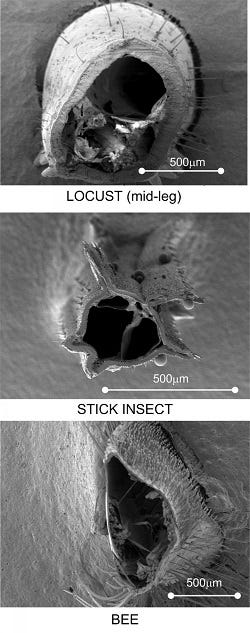Insect legs could help engineers improve the safety of long tubular structures used in aircraft to reduce weight and in hospital equipment, such as catheters. Scientists from Trinity College Dublin are looking at how the different leg shapes of locusts, cockroaches, stick insects and bees bend and buckle when stress is applied to them.
July 8, 2015
Insect legs could help engineers improve the safety of long tubular structures used in aircraft to reduce weight and in hospital equipment, such as catheters. Scientists from Trinity College Dublin are looking at how the different leg shapes of locusts, cockroaches, stick insects and bees bend and buckle when stress is applied to them.
|
Insect legs can provide valuable information on the buckling properties of long tubular structures, potentially helping designers of catheter and aircraft. |
"Thin-walled tubes are prone to failure by buckling", said Professor David Taylor, one of the lead researchers. "It is difficult to predict the loading conditions which cause buckling, especially for tubes of non-standard cross section. Think of a drinking straw. If you bend it, it will suddenly give."
The researchers chose insects with different leg shape and lifestyles. Stick insects have five longitudinal ridges running down their legs. "We discovered that these ridges do not prevent buckling", said Taylor, "but they do help the legs stay intact. In particular, they help resist a particular type of buckling called elastic buckling. This shows how material properties and geometry can interact in complex ways, which must be taken into account when designing thin-walled tubes."
Bees have legs with a triangular cross section featuring a large flat area where a pollen basket is found. The researchers found that this did not significantly affect the bending moment to failure, showing that non-circular cross sections can be designed without compromising mechanical strength.
Locusts and cockroaches have hollow legs with near-circular cross sections and come close to breaking their legs when they jump. "Essentially they get close to the limit. This is evolution operating close to the edge", said Taylor.
It is hoped that understanding insect cuticle will inspire future biomimetic materials (i.e. materials inspired by nature). "Even though the arthropod cuticle is one of the most common materials in the world, we don't know very much about it", said Taylor.
The next steps of this research involve testing how living insects respond to stress.
You May Also Like



